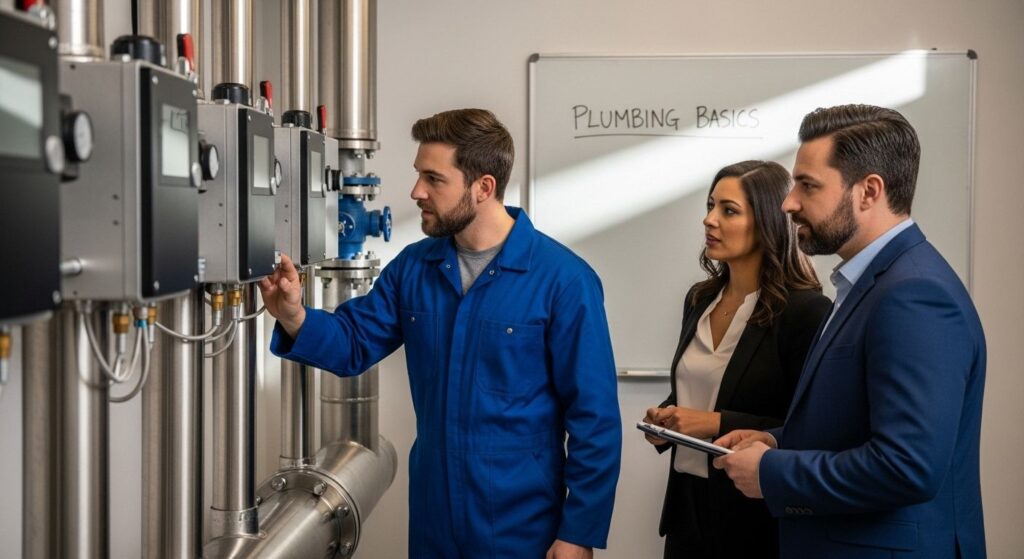Commercial plumbing keeps hospitals, schools, and office towers running smoothly each day. Yet these complex systems work much harder than anything found in a regular house. In fact, inefficient plumbing in businesses can waste thousands of dollars every year and even lead to damaged property or surprise shutdowns. Most business owners never realize just how detailed and demanding their plumbing setup truly is.
The following table summarizes key differences between commercial and residential plumbing to help readers quickly compare the two systems and understand why commercial plumbing requires more specialized management.
| Aspect | Commercial Plumbing | Residential Plumbing |
|---|---|---|
| Scale & Complexity | Large, multi-storey buildings; intricate | Single dwellings; simpler systems |
| Water Volume | Much higher and more variable usage | Lower, more consistent usage |
| Materials Used | Stainless steel, high-grade copper, | Standard copper, PVC |
| specialized PVC for durability | ||
| Maintenance Frequency | Requires frequent inspections and | Less frequent, typically on-demand |
| preventative maintenance | ||
| Regulatory Standards | Stricter, subject to health and safety laws | Basic building codes |
| Typical Users | Businesses, hospitals, schools, factories | Homeowners |
| Operational Risks | Greater risk of costly disruptions and | Lower risk, fewer potential issues |
| penalties if not properly managed |
Table of Contents
- What Is Commercial Plumbing and Its Components?
- Why Understanding Commercial Plumbing Is Essential for Businesses
- How Commercial Plumbing Systems Function
- Key Concepts in Commercial Plumbing Maintenance
- Exploring Common Challenges in Commercial Plumbing
Quick Summary
| Takeaway | Explanation |
|---|---|
| Commercial plumbing is complex and vital | It serves businesses with specialized systems that require rigorous maintenance and compliance. |
| Preventative maintenance minimizes operational risks | Regular inspections and timely repairs can prevent costly disruptions and extend system lifespan. |
| Understanding compliance reduces penalties | Knowledge of local regulations ensures safety and helps avoid legal challenges related to plumbing systems. |
| Advanced monitoring enhances system performance | Real-time diagnostic technologies can detect issues early and optimize plumbing operations. |
| Investing in quality materials pays off | Durable materials lead to better performance and lower long-term repair costs in commercial plumbing systems. |
What is Commercial Plumbing and Its Components?
Commercial plumbing represents a specialized domain of professional plumbing services designed specifically for businesses, institutions, and large-scale facilities. Unlike residential plumbing, commercial plumbing systems demand more complex infrastructure, higher performance standards, and rigorous maintenance protocols to support extensive water and waste management needs.
Defining Commercial Plumbing Systems
Commercial plumbing encompasses intricate networks of pipes, fixtures, and equipment that serve large-scale buildings such as offices, restaurants, hospitals, schools, and industrial facilities. These systems must handle significantly higher water volumes, more frequent usage, and stricter regulatory compliance compared to residential setups.
The core components of commercial plumbing typically include:

- Water Supply Lines: Large diameter pipes capable of delivering substantial water volumes
- Drainage Systems: Complex networks designed to manage waste efficiently
- Fixtures and Appliances: High-performance equipment engineered for commercial environments
Key Technical Characteristics
Commercial plumbing systems are engineered with unique specifications that differentiate them from residential installations. According to the National Association of Plumbing Contractors, these systems must meet more stringent building codes, handle higher water pressures, and incorporate advanced materials like stainless steel, copper, and specialized PVC pipes that can withstand intense operational demands.
Businesses require robust plumbing infrastructure that minimizes downtime and potential disruptions. This means selecting materials and designing systems that can endure constant use, resist corrosion, and maintain optimal performance under varying environmental conditions. Learn more about complex commercial plumbing solutions that ensure seamless operational continuity for Ottawa businesses.
The complexity of commercial plumbing extends beyond mere water transportation. These systems must integrate multiple subsystems including water heating, filtration, backflow prevention, and waste management technologies. Proper design and maintenance are critical to preventing potential business interruptions, health code violations, and expensive infrastructure failures.
This table outlines core components of commercial plumbing systems and their specific functions, providing an at-a-glance reference for business owners to understand what each element contributes to system performance.
| Component | Function |
|---|---|
| Water Supply Lines | Deliver large volumes of water throughout the facility |
| Drainage Systems | Efficiently remove wastewater and prevent blockages |
| Fixtures and Appliances | Withstand heavy, frequent use and meet commercial demands |
| Pressure Management | Maintain consistent and safe water pressure across all zones |
| Backflow Prevention | Protect potable water from contamination |
| Filtration Systems | Enhance water quality and address safety codes |
| Grease Interceptors | Trap fats, oils, and grease to prevent drainage issues |
| Diagnostic Sensors | Monitor performance and detect leaks or anomalies in real time |
Professional commercial plumbers must possess specialized knowledge in engineering principles, building regulations, and advanced technical installation techniques to successfully design, implement, and maintain these sophisticated systems.
Why Understanding Commercial Plumbing is Essential for Businesses
Commercial plumbing represents more than just a technical infrastructure it is a critical business asset that directly impacts operational efficiency, financial performance, and regulatory compliance. Business owners who comprehend the nuanced complexities of their plumbing systems can proactively prevent costly disruptions and maintain optimal facility performance.
Financial and Operational Implications
Understanding commercial plumbing goes far beyond basic maintenance. Inefficient plumbing systems can lead to substantial financial losses through increased utility expenses, unexpected repair costs, and potential business interruptions. Water leaks, for instance, can waste thousands of dollars annually and compromise building structural integrity.
Key financial risks associated with poor plumbing management include:
- Unexpected repair expenses
- High water consumption costs
- Potential property damage
- Business downtime during major repairs
Regulatory Compliance and Safety Standards
According to the Environmental Protection Agency, commercial facilities must adhere to strict water efficiency and safety regulations. Businesses that fail to maintain proper plumbing standards risk significant penalties, potential legal challenges, and reputational damage.
Professional plumbing knowledge enables businesses to:
- Ensure compliance with municipal health codes
- Prevent contamination risks
- Maintain safe water distribution systems
- Implement sustainable water management practices
Preventative Maintenance Strategy
Proactive plumbing management is a strategic approach that transforms potential problems into manageable systems. Our comprehensive guide to commercial plumbing challenges offers insights into early detection and prevention techniques.
By investing time in understanding their plumbing infrastructure, businesses can develop robust maintenance strategies that minimize risks, reduce long term expenses, and ensure continuous operational excellence. Professional commercial plumbers recommend regular inspections, comprehensive system assessments, and implementing advanced monitoring technologies to maintain optimal plumbing performance.
Ultimately, commercial plumbing knowledge is not just a technical requirement but a critical business intelligence tool that drives efficiency, safety, and financial sustainability.
How Commercial Plumbing Systems Function
Commercial plumbing systems represent intricate networks of interconnected components designed to efficiently manage water supply, waste removal, and overall fluid dynamics within large-scale facilities. These sophisticated systems function through carefully engineered mechanisms that ensure reliable performance, precise water distribution, and comprehensive waste management.
Water Supply and Distribution Mechanisms
Water supply systems in commercial environments operate through complex networks of high-capacity pipes, valves, and pressure regulators. These systems must accommodate dramatically different water volume requirements compared to residential setups. Large diameter pipes strategically routed throughout buildings enable consistent water pressure and flow across multiple floors and diverse usage zones.
Key components of water distribution include:
- Primary water intake lines
- Pressure management systems
- Backflow prevention devices
- Separate hot and cold water circuits
Waste Management and Drainage Technologies
According to the Plumbing and Drainage Institute, commercial drainage systems utilize advanced engineering principles to manage substantial waste volumes efficiently. These systems incorporate multiple interconnected subsystems that prevent potential blockages, control odors, and maintain hygienic conditions.
Drainage technologies typically involve:
- Gravity-based waste removal mechanisms
- Specialized grease interceptors
- Chemical waste neutralization systems
- Multilayered filtration networks
Advanced Monitoring and Control Systems
Modern commercial plumbing infrastructure integrates sophisticated digital monitoring technologies that enable real-time performance tracking. Explore our comprehensive guide to advanced plumbing solutions to understand how these systems prevent potential operational disruptions.
Professional plumbing engineers design these systems with redundancy and failsafe mechanisms. Automated sensors continuously monitor water pressure, temperature, flow rates, and potential leak indicators. These intelligent systems can instantly detect anomalies, trigger emergency protocols, and provide comprehensive diagnostic information to maintenance teams.
The complexity of commercial plumbing systems extends far beyond simple water transportation. They represent dynamic, integrated networks that balance engineering precision, technological innovation, and strict regulatory compliance to support business operations efficiently and safely.
Key Concepts in Commercial Plumbing Maintenance
Commercial plumbing maintenance represents a strategic approach to preserving infrastructure integrity, preventing operational disruptions, and ensuring long-term system performance. Successful maintenance goes beyond routine repairs, encompassing comprehensive monitoring, proactive interventions, and sophisticated diagnostic techniques.
Preventative Maintenance Strategies
Systematic maintenance is the cornerstone of effective commercial plumbing management. Unlike reactive approaches that address problems after they occur, preventative strategies focus on early detection, regular inspections, and scheduled interventions that minimize potential system failures.
Critical preventative maintenance components include:
- Comprehensive annual system assessments
- Routine pipeline and fixture inspections
- Predictive performance monitoring
- Scheduled replacement of high-wear components
Diagnostic and Monitoring Technologies
According to facility management experts, modern commercial plumbing maintenance leverages advanced diagnostic technologies to identify potential issues before they escalate. Sophisticated sensors, thermal imaging, and digital monitoring systems enable real-time performance tracking and early anomaly detection.
Key diagnostic technologies involve:
- Acoustic leak detection systems
- Infrared thermal scanning
- Pressure and flow rate monitoring
- Digital pipeline mapping and tracking
Compliance and Documentation Management
Explore our comprehensive maintenance guide for Ottawa property owners to understand the nuanced requirements of professional plumbing maintenance.
Maintenance is not merely a technical process but a comprehensive documentation and compliance management strategy. Professional commercial plumbers maintain detailed records of inspections, repairs, system modifications, and performance metrics. These documentation practices support regulatory compliance, facilitate predictive maintenance, and provide valuable insights into system health and potential future investments.
Effective commercial plumbing maintenance represents a sophisticated blend of technical expertise, advanced technologies, and strategic planning. By implementing robust maintenance protocols, businesses can significantly reduce operational risks, extend infrastructure lifespan, and optimize overall system performance.

Exploring Common Challenges in Commercial Plumbing
Commercial plumbing systems confront unique and complex challenges that demand sophisticated problem-solving approaches. These challenges extend beyond typical residential plumbing issues, requiring specialized knowledge, advanced diagnostic techniques, and strategic intervention strategies that protect business operations and infrastructure integrity.
Infrastructure Stress and Deterioration
Commercial plumbing systems experience significantly higher operational stress compared to residential setups. Continuous usage, diverse environmental conditions, and complex network designs contribute to accelerated infrastructure wear and potential systemic failures. Buildings with multiple floors, extensive piping networks, and varied water usage patterns create unique strain on plumbing components.
Primary infrastructure stress factors include:
- High-volume water flow variations
- Temperature and pressure fluctuations
- Material degradation over time
- Cumulative mechanical wear on fixtures
Complex Contamination and Hygiene Risks
According to the Canadian Institute of Plumbing and Heating, commercial facilities face intricate contamination challenges that require rigorous monitoring and intervention. Different industry sectors present unique contamination risks, from food service grease accumulation to chemical waste management in industrial settings.
Key contamination risk areas encompass:
- Cross-connection potential
- Bacterial growth in stagnant water systems
- Chemical interaction within drainage networks
- Biofilm development in complex piping configurations
Regulatory Compliance and Performance Management
Discover comprehensive insights into commercial plumbing challenges and learn strategic approaches to mitigating potential system failures.
Navigating regulatory landscapes presents another significant challenge for commercial plumbing systems. Municipal health codes, environmental regulations, and industry-specific standards create complex compliance requirements. Professional plumbers must continuously adapt to evolving standards while maintaining optimal system performance and ensuring public safety.
Successful commercial plumbing management requires a holistic approach that balances technical expertise, proactive maintenance, advanced diagnostic capabilities, and comprehensive understanding of systemic interdependencies. By anticipating and addressing potential challenges strategically, businesses can minimize disruptions and maintain robust, efficient plumbing infrastructure.
Protect Your Ottawa Business with Trusted Commercial Plumbing Experts
Complex plumbing systems are essential for your business’s performance, but a single leak or blockage can threaten daily operations and jeopardize compliance. The article highlights how challenges in commercial plumbing—like high water volumes, regulatory risks, and the need for proactive maintenance—can quickly turn into costly emergencies. Many Ottawa businesses struggle with downtime, unexpected repair expenses, and health code violations simply because their plumbing system is not professionally managed.

Choose peace of mind and uninterrupted business operations by working with a dedicated local team. At Delta Plumbers Ottawa, we understand the unique technical needs of commercial buildings and offer 24/7 emergency support, routine maintenance, and transparent flat-rate pricing for companies across the city. Explore solutions for your toughest plumbing problems by visiting our range of commercial plumbing services or reach out directly at https://deltaplumbersottawa.com. Act now to secure professional help before a minor issue becomes your next major disruption.
Frequently Asked Questions
What are the key components of commercial plumbing systems?
The key components of commercial plumbing systems include water supply lines, drainage systems, and high-performance fixtures and appliances designed to meet the demands of large-scale facilities.
How does commercial plumbing differ from residential plumbing?
Commercial plumbing systems are more complex and must handle higher volumes of water and waste. They require specialized materials, advanced technologies, and compliance with stricter regulations compared to residential plumbing.
Why is preventative maintenance important for commercial plumbing?
Preventative maintenance is crucial as it helps identify potential issues before they escalate, reduces unexpected repair costs, extends the lifespan of plumbing infrastructure, and ensures compliance with safety and regulatory standards.
What challenges do commercial plumbing systems face?
Commercial plumbing systems face challenges such as infrastructure stress from high usage, contamination risks, and the need to comply with evolving regulatory standards. These factors can lead to operational failures if not properly managed.









